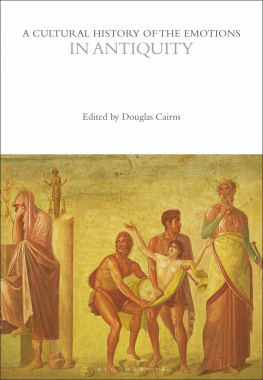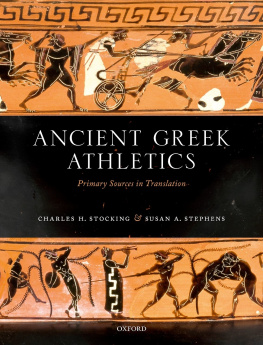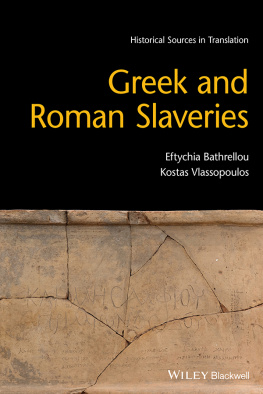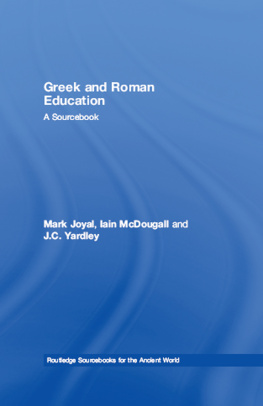
A CULTURAL HISTORY
OF THE EMOTIONS
VOLUME 1
A Cultural History of the Emotions
General Editors: Susan Broomhall, Jane W. Davidson, and Andrew Lynch
Volume 1
A Cultural History of the Emotions in Antiquity
Edited by Douglas Cairns
Volume 2
A Cultural History of the Emotions in the Medieval Age
Edited by Juanita Ruys and Clare Monagle
Volume 3
A Cultural History of the Emotions in the Late Medieval, Reformation, and Renaissance Age
Edited by Andrew Lynch and Susan Broomhall
Volume 4
A Cultural History of the Emotions in the Baroque and Enlightenment Age
Edited by Claire Walker, Katie Barclay, and David Lemmings
Volume 5
A Cultural History of the Emotions in the Age of Romanticism, Revolution, and Empire
Edited by Susan J. Matt
Volume 6
A Cultural History of the Emotions in the Modern and Post-Modern Age
Edited by Jane W. Davidson and Joy Damousi

CONTENTS
CHAPTER 1
Portrait of Hippocrates holding his Apophthegms. Fourteenth-century Byzantine miniature. Paris, Bibliotheque nationale. Photo by Photo 12/Alamy Stock Photo.
Achilles binds Patroclus wound. Attic red-figure drinking cup by the Sosias Painter, c. 510490 BCE . Berlin, Antikensammlung, Staatliche Museen zu Berlin F 2278. Photo by Azoor Photo/Alamy Stock Photo.
Attic votive relief for Amphiaraos in Oropos, dedicated by Archinos, 400350 BCE . Athens NM 3369. Athens, National Archaeological Museum. Photo: Eirini Miari. Hellenic Ministry of Culture and Sports/Archaeological Receipts Fund.
Red-figure aryballos with depictions of blood-letting. Paris, Louvre. Photo by DEA/G. Dagli Orti.
CHAPTER 2
Marble statuette of Nemesis with portrait resembling the Empress Faustina I. Roman Empire, c. 150 CE . In her left hand she holds a wheel of fate. Photo by Artokoloro Quint Lox Limited/Alamy Stock Photo.
Neo-Attic sarcophagus, 5040 BCE . In the center, Ers and Anters are portrayed as twins, while on both the left and right a centaur appears, one with a satyr on his back and the other with a maenad. Galleria dei Busti, Museo Pio Clementino, Vatican. Vanni Archive/Art Resource, New York.
A copy of an engraving made of the reverse of a rare gold coin of Commodus, featuring at the bottom the abbreviation Conc Mil, for Concordia Militum, or Concordia among the Soldiers. The rest of the legend reads P M TR P XI IMP VIII COS V PP, or Pontifex Maximus, Tribune of the People for the eleventh time, Imperator for the seventh time, Consul for the fifth, and Father of his Country. From W. Stevenson, C. R. Smith, and F. W. Madden (eds), The Dictionary of Roman Coins, Republican and Imperial (London: Seaby, 1889), p. 244.
CHAPTER 3
Women lamenting during a prothesis. Attic black-figure funerary plaque, c. 520510 BCE . New York, Metropolitan Museum of Art, 54.11.5.
Dionysus with satyrs and maenads playing music. Attic red-figure bell krater, c. 450 BCE , attributed to the Methyse Painter. New York, Metropolitan Museum of Art, 07.286.85.
Dancing maenad. Terracotta plaque, Roman, c. first century BCE first century CE . New York, Metropolitan Museum of Art, 12.232.8b
Orpheus enchanting the Thracians with the lyre. Red-figure krater from Gela, c. 450 BCE , detail. Berlin, Antikensammlung, Staatliche Museen zu Berlin. 2017. Photo Scala, Florence/bpk, Bildagentur fr Kunst, Kultur und Geschichte, Berlin.
Women enchanted by barbitos music in a domestic setting. Attic red-figure bell krater, c. 460 BCE , attributed to the Danae Painter. New York, Metropolitan Museum of Art, 23.160.80.
CHAPTER 4
Tragic mask, first century BCE or CE . Oxford, Ashmolean Museum. C. Raddato via Wikimedia Commons. This file is licensed under the Creative Commons Attribution-Share Alike 2.0 Generic license.
Glykera (left) after her hair has been shorn in Act 1 of Menanders Perikeiromene, with Polemon (seated) and the slave Sosias; from the Antioch mosaics (c. third century CE ). Photo courtesy of the excavator, mer elik. See K. Gutzwiller and . elik, New Menander Mosaics from Antioch, American Journal of Archaeology 116 (2012): 573623.
Comic masks; from the preface to the Andria in a manuscript of Terences comedies. Paris, Bibliothque nationale de France, MS Latin 7899 (ninth century). See S. Nervegna, Graphic Comedy: Menandrian Mosaics and Terentian Miniatures, in M. Fontaine and A. C. Scafuro, The Oxford Handbook of Greek and Roman Comedy (Oxford: Oxford University Press, 2014), 71734. Courtesy of Bibliothque nationale de France.
Comedy scene depicted in the Roman mosaic from Villa de Cicero (Villa of Cicero) in Pompeii, now on display in the National Archaeological Museum (Museo Archeologico Nazionale di Napoli) in Naples, Campania, Italy. Two women consulting with a witch are depicted in the mosaic. Signature on the top: signed by Dioskourides of Samos. Photo by Azoor Photo/Alamy Stock Photo.
A moment in Act 2 of Menanders Phasma or The Ghost when the ghost makes its appearance; from the Mytilene mosaics, photo courtesy of Professor Kyriaki Ioannidou (University College, London), Archaeological Museum, Mytilene. See E. G. Turner, The Phasma of Menander, Greek, Roman, and Byzantine Studies (1969) 307-24, esp. p. 320.
CHAPTER 5
Centaur biting Lapith, western pediment of the temple of Zeus at Olympia, c. 460 BCE . Olympia, Archaeological Museum. Museum fr Abgsse Klassischer Bildwerke Mnchen. Photo: Walter Hege/Museum fr Abgsse Klassischer Bildwerke Mnchen.
Pasquino Group, Roman copy from Hellenistic original, c. 150120 BCE . Florence, Loggia dei Lanzi. Photo by Tommaso Di Girolamo/AGF/UIG via Getty Images.
Poseidon chasing Amymone. Athenian lekythos, c. 420 BCE . New York, Metropolitan Museum of Art 17.230.35. Metropolitan Museum of Art.
Athenian lekythos, c. 430 BCE . Athens, National Museum 1935. Hellenic Ministry of Culture and Sports/Archaeological Receipts Fund.
Roman sarcophagus, 120130 CE . Agrigento, Museo Nazionale. Photo by Christophe Boisvieux via Getty Images.
Wall painting from the House of the Tragic Poet in Pompeii, 6279 CE . Naples, National Archaeological Museum 9112. Photo by Mondadori Portfolio via Getty Images.
John F. Kennedys family at his funeral in Washington, DC, November 1963. Photo by Keystone/Getty Images.
Athenian krater, c. 450 BCE . Paris, Louvre G 424. bpk/Mus du Louvre, Dist. RMN-Grand Palais/Stphane Marchalle.
Wedding ceremony. Athenian loutrophoros, 420 BCE . Oxford, Ashmolean Museum 1966.888. Ashmolean Museum, University of Oxford.
Fresco from the House of Punished Love, Pompeii, c. 20 CE. Naples, National Archaeological Museum. Photo by DeAgostini/Getty Images.
Fresco from the House of Punished Love, Pompeii, c. 20 CE. Naples, National Archaeological Museum. Photo by Leemage/Corbis via Getty Images.
Athenian grave stele of Korallion (drawing), c. 350 BCE . Athens, Kerameikos Museum P688. After Conze 1893: pl. 98.
Roman funerary altar, first century CE . Rome, Museo Nazionale Romano 124514. Photo by DEA/A. Dagli Orti/De Agostini/Getty Images.
Next page











